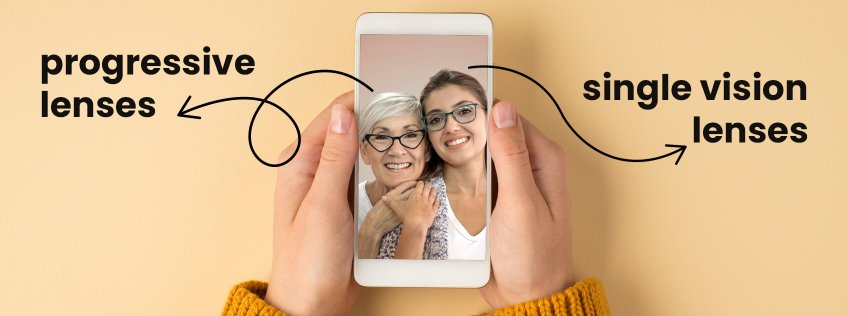Centre-du-Québec
Chaudière-Appalaches
Eastern Townships
Lac Saint-Jean
Lanaudière
Montérégie
Montreal
North Shore
Outaouais
Centre-du-Québec
Eastern Townships
Lac Saint-Jean
Lanaudière
Montérégie
Outaouais
Centre-du-Québec
Chaudière-Appalaches
Eastern Townships
Lac Saint-Jean
Lanaudière
Montérégie
Montreal
North Shore
Outaouais
Back to articles
Single Vision or Progressive Lenses: Learn How to Tell Them Apart!

To better correct your unique vision needs, there are two main lens categories: single vision and progressive. A wide range of eyewear options are available, varying in quality and specifically geared towards your needs and budget. Do you know how to choose the right lenses? Read on for everything there is to know about single vision and progressive lenses!
What are single vision lenses?
Single vision, or unifocal lenses, are lenses that have a continuous power over the entire lens. They are prescribed particularly to help correct myopia, hyperopia, and astigmatism. Depending on your prescription, single vision lenses will correct near vision to accommodate the distance between your eyes and a book for example, or intermediate vision, for distance equivalent to that between your eyes and a computer screen, or distance vision such as when you are watching TV.
The price of single vision lenses can vary depending on the technologies involved in their design. Today’s single vision lenses benefit from more advanced innovations, which can reduce visual distortion in the corners of the lens or can even be customized to provide the optimum angle of vision for the shape of your eye.
Some single vision lenses are also specifically designed for those whose eyes are frequently fatigued by screens and who need glasses adapted to their online lifestyle.
What Are Progressive Lenses?
Progressive lenses are designed to accommodate both distance vision, in the upper segment of the lens, and near vision, by increasing the power in the lower segment of the lens. This type of lens is most often used to correct presbyopia, a condition that occurs with the natural aging of the eye, generally around the age of 40. Progressive lenses offer optimal vision adapted to eye movements, regardless of the distance. There is a wide variety of progressive lenses, but they are not all created equal.
Modern progressive lenses are a true marvel of optical innovation, gone are the days of multifocal lenses with their highly visible markings offering poor vision fluidity. Some high range progressive lenses are now designed with the help of artificial intelligence to adapt to the eye’s natural movement and to avoid distortion and delays in vision sharpness.
More affordable “lifestyle” glasses, also known as reading or computer glasses, operate on the same principles: computer glasses correct intermediate vision at the top of the lens and near vision at the bottom of the lens for those who want a more comfortable vision when using screens, sheet music or other creative pastimes requiring intermediate vision – at an arm’s distance. Not having distance vision allows for a wider intermediate field of vision, as well as a much smoother variation in power between the top and bottom of the lens than a progressive lens.
A Lenses Adapted to your Unique Vision
Several other specialty lenses are also available to better meet your needs: from lenses to control myopia in children, to safety lenses, to lenses specially designed for sports and outdoor activities, there’s a lens to suit your lifestyle and protect your eyes in all conditions.
Would you like to see more clearly? Ask your optician to help you make an informed decision about the lenses and frames best suited to your needs; book an appointment at an OPTOPLUS clinic today to take advantage of the advice of our eye health experts!
